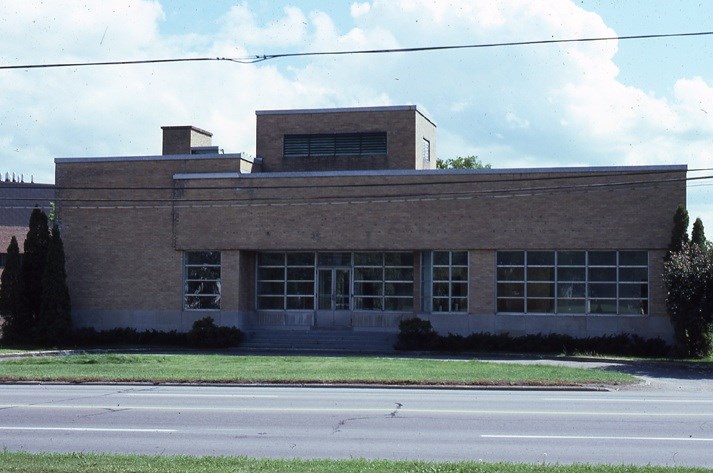From the archives of the Sault Ste. Marie Public Library:
*************************
Remember This… The “Bug Lab”
The Great Lakes Forestry Centre is one of five research centres in Canada. Our local “Bug Lab” has a long history in Sault Ste. Marie and has had many different names throughout the years.
In 1941, the need to control insect pests led to the beginning of the Insect Pathology Research Institute. In 1945, a new building was constructed on Church Street in response to a massive outbreak of spruce budworm. This building was a joint effort between the provincial and federal forestry departments. The province provided the building while the federal government supplied the staff and equipment.
By 1948, the staff had grown rapidly, increasing from 15 up to 168 people. Much of their work involved working with the insect samples of diseased trees. In an effort to ensure that these forest insect pests were contained in a secure and isolated environment a new building was constructed and opened in 1950 at 1195 Queen Street, specifically for the Laboratory of Insect Pathology. The construction of the building and the measures taken by staff ensured that they operated in a quarantined environment so that none of the insects that they were working with could escape outside. It was renamed the Insect Pathology Research Institute in 1959 before eventually becoming known as the Forest Pest Management Institute. Over the next few years the staff continued to increase in size and additional work space was achieved by adding portables but it soon became necessary to consider an addition or erecting a new building.
In 1965, the federal government decided to consolidate the forestry operations in Ontario and relocated the Richmond Hill and Maple, Ontario offices to Sault Ste. Marie to form the Great Lakes Forest Research Centre. Sault Ste. Marie was selected as a location over Maple and Richmond Hill due to its close proximity to forests and forestry industries.
At the time, 87 per cent of the productive forests of Ontario were located in the Sault Ste. Marie area and provided 93 per cent of the wood cut in the province. Also, 18 of the 27 pulp paper mills in Ontario were located north of Lake Superior and Lake Huron.
In a newspaper article from 1974, Dr. J.M. Cameron, director of the Forest Pest Management Institute described three of their top scientists, Dr. F.T. (Ted) Bird, Dr. Tom Angus and Dr. Don McLeod as the “three musketeers” of insect pathology because of their ongoing work at protecting our Canadian forests from the forest pests. Their research was considered proactive in trying to solve problems rather than reactive to an existing problem.
In the late 1960s, plans were drawn up — with construction getting underway in the early 1970s — for the new Great Lakes Forest Research Centre. The official opening of this beautiful and high tech science laboratory was held in April of 1976. The cost was approximately $8 million and it became home to approximately 150 research, administrative and support staff of the Great Lakes Forest Research Centre, 30 staff from the Insect Pathology Research Institute, three from the Canadian Wildlife Service and three from the Water Survey Branch of the Inland Waters Directorate. It has now become a major landmark in the city.
Over the years the research being conducted at the Great Lakes Forest Research Centre has expanded to include forest fire and climate change which may include using computer models to evaluate strategic forestry management and forest sustainability. The Bug Lab’s mandate has expanded as well to include detection and control of many other invasive species such as the gypsy moth, tussock moth, emerald ash borer and the Asian long horned beetle using naturally occurring micro-organisms. This allows the targeting of invasive insect species without killing useful domestic insects or harming other animal or human life.
The year 2007 was an important year in the history of the Great Lakes Forest Centre. In partnership with other facilities they were able to research a variety of plant species in order to develop a biofuel as an alternative to fossil fuel. In addition, three local scientists Richard Fleming, Ian Thompson and Mike Flannigan won a Nobel Peace Prize as part of the Intergovernmental Panel on Climate Change. This group’s work documented global warming and climate change and its effects for over 20 years. In 2009, the facility was once again expanded to help accommodate the ever-growing mandate in scientific research in order to protect our nation’s forests.
For more than 70 years the Great Lakes Forestry Centre has worked to protect our natural resources, both locally and worldwide which has made them world renowned in their field of work and an organization that we can be proud to have in our community.
*************************
Each week, the Sault Ste. Marie Public Library and its Archives provides SooToday readers with a glimpse of the city’s past.
Find out more of what the Public Library has to offer at www.ssmpl.ca and look for more Remember This? columns here
